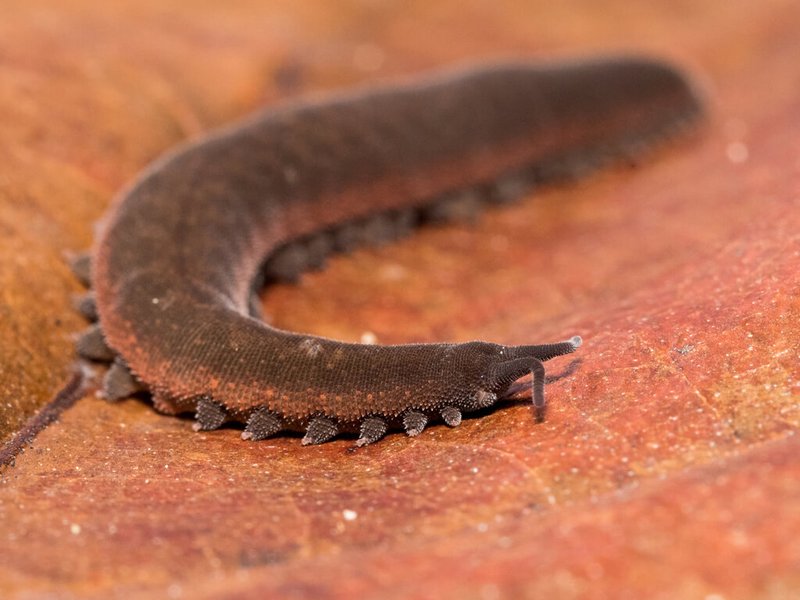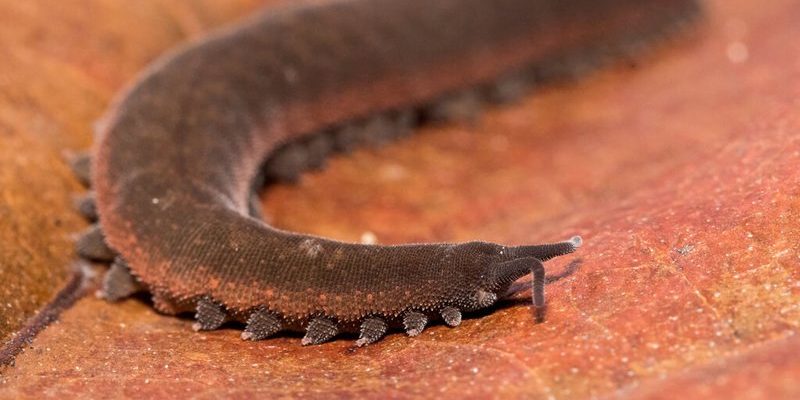
Just like our eight-legged friends, velvet worms have adapted uniquely to their environments. But before diving into how they hunt, let’s explore what makes both of these creatures so interesting. While spiders are widespread and often feared, velvet worms remain a bit more mysterious, lurking in the leaf litter of moist forests. So, grab your coffee, and let’s unravel the intriguing similarities and differences in their hunting habits!
Understanding the Velvet Worm
Velvet worms, or *Onychophora*, are fascinating creatures found in humid environments across the globe. With their soft, velvety bodies, they might look like a sluggish caterpillar, but they’re quite distinct. These little critters can grow up to several inches long, sporting multiple pairs of legs that give them a unique, almost alien appearance. They tend to live in leaf litter or under logs, where they can find their favorite meals—small insects and other invertebrates.
Their bodies are covered in a layer of slime, which they use for various purposes. This slime isn’t just for show; it plays a crucial role when they hunt. Velvet worms can produce this slime to ensnare their prey, immobilizing it before consumption. It’s a bit like a secret weapon in their hunting toolkit!
You might be wondering how velvet worms are able to hunt effectively in their environment. The key lies in their ability to sense their surroundings. They have tiny sensory structures on their antennae that help detect vibrations and smells. This enables them to locate potential meals, even in the dark, damp places they call home.
The Spider’s Hunting Tactics
Now, let’s shift gears to explore our eight-legged friends. Spiders belong to a vast group of creatures, with over 40,000 species worldwide. Their hunting strategies vary widely—some spin intricate webs, while others are stealthy ambush predators. For instance, orb-weavers create stunning webs that act like traps for unsuspecting insects. Once trapped, they inject venom to immobilize their prey and then feast on it.
Other spider species, like jumping spiders, don’t rely on webs at all. Instead, they hunt actively, using their keen eyesight to stalk and pounce on unsuspecting prey. Imagine a little ninja spider leaping across your garden! Their hunting tactics are largely influenced by their environment and the type of prey they target.
One of the most remarkable aspects of a spider’s hunting strategy is its ability to produce silk. Not just for webs, spiders can create silk for various uses, including safety lines and wrapping prey. This versatility showcases their adaptability and ingenuity, making them fascinating hunters in the animal kingdom.
Comparing Hunting Techniques
So, how do velvet worms and spiders compare when it comes to hunting? While both are predators, their techniques reflect their unique adaptations. Velvet worms primarily rely on their **slime** and stealth, while spiders employ webs or surprising agility.
– **Hunting Style**: Velvet worms ambush their prey, using slime as a sticky net. In contrast, many spiders use webs to trap and immobilize their meals.
– **Speed and Agility**: Spiders can be incredibly fast; they dart in and out to catch meals. Velvet worms, however, aren’t as quick, making their stealth approach vital.
– **Prey Selection**: Both creatures enjoy soft-bodied invertebrates, but spiders have a wider variety of targets, thanks to their hunting flexibility and adaptability.
Ultimately, both velvet worms and spiders have evolved to become successful hunters in their respective environments. Their strategies highlight how diverse life can be in the animal kingdom!
Physical Adaptations for Hunting
Both velvet worms and spiders possess unique physical adaptations that enhance their hunting capabilities. Let’s break down a few key features.
**Velvet Worms**:
– **Slime Production**: This is perhaps their most notable feature. The slime helps them catch prey by wrapping around it, making escape nearly impossible.
– **Flexible Bodies**: Their柔滑 bodies allow them to navigate through leaf litter and find hiding spots effectively.
**Spiders**:
– **Silk Glands**: Spiders can produce different types of silk for various purposes: hunting, safety, and even creating egg sacs.
– **Complex Eyes**: Many spider species have excellent vision, allowing them to track movement and gauge distances effectively—essential for hunting.
These adaptations not only aid in hunting but also play a role in their survival strategies. They show how different life forms have tailored their bodies and skills to thrive in their niches.
The Role of Environment in Hunting Behavior
The environments that velvet worms and spiders inhabit greatly influence their hunting strategies. Velvet worms thrive in humid, leaf-litter-rich settings, preferring darkness and moist conditions. This habitat provides a steady supply of prey and protection from predators. Their hunting behavior aligns perfectly with these environmental factors, allowing them to camouflage and ambush effectively.
Spiders, on the other hand, are found in various habitats, including fields, forests, and even urban areas. Some are web builders, creating elaborate structures in trees or corners of homes, while others thrive in open spaces, ready to pounce. The diversity of their environments has led to a wide array of hunting techniques, making spiders incredibly adaptable.
The synergy between environment and hunting strategy highlights the importance of ecological niches. Each creature has carved out a space where it can thrive, using its unique arsenal of hunting techniques.
Why Studying Velvet Worms is Important
You might be asking, “Why should I care about velvet worms?” Well, studying them sheds light on the whole spectrum of ecological interactions and adaptations. These creatures are often seen as indicators of environmental health, especially in tropical ecosystems. Their presence can signal a balanced habitat, while their decline may indicate environmental troubles.
Researching velvet worms can also provide insights into evolutionary biology. Understanding how they’ve adapted their hunting strategies alongside spiders sheds light on the intricate web of life. Plus, it can help scientists develop conservation strategies for vulnerable habitats.
So, while they may seem strange, velvet worms play an essential role in the biodiversity of our planet. Their unique skills and adaptations have much to teach us about balance in nature!
The Fascination of Velvet Worms and Spiders
Both velvet worms and spiders captivate those who study them. Their hunting behaviors offer a glimpse into the complexity of life and evolution. As you learn about these creatures, it becomes clear that they represent more than just predators; they embody the balance of ecosystems.
Their differences are fascinating, but so are their similarities. Both showcase incredible adaptations honed by millions of years of evolution. The velvet worm’s stealth and slime complement the spider’s speed and silk, creating a diverse tableau in the animal kingdom.
Understanding these hunting behaviors can inspire curiosity about the natural world. So, next time you encounter a spider in your garden or stumble upon a velvet worm in the forest, take a moment to appreciate the complexity and beauty of these extraordinary creatures!
In essence, both velvet worms and spiders offer unique perspectives on hunting and survival in nature. Their behaviors teach us about adaptability and the intricate relationships between species and their environments. As we explore the wonders of these creatures, we gain a deeper appreciation for life on Earth. So, keep your eyes open, nature is full of surprises!

